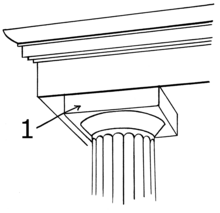Abacus (architecture)
An abacus (from Greek abax (ἄβαξ) tabletop and Abakion , Latin abacus ) referred to in the architecture of antiquity a square plate, in particular the square cover plate of the capitals . The cover plate forms the upper end of the capital and thus the entire column. The architrave usually rests on the abacus .
In the Doric column arrangement , the side edges of the abacus run perpendicular to the floor, it is flat and not structured. Vitruvius does not designate the cover plate of the Doric capital as an abacus, but as a plinth - in contrast to modern architectural terminology .
In the Ionic and Corinthian , the abacus is slightly profiled by a fillet and ledge.
In the case of the Corinthian order and the composite capital, the sides of the abacus are concave. In the Corinthian chapter there is a flower or rosette, the abacus flower, in the middle of each of the four sides .
The use of the abacus is the rule in antiquity and the architectural styles that imitate it, while in early Christian or Byzantine architecture it is often replaced by a warrior's attachment . In the Middle Ages, the abacus can also be omitted without replacement.
In the Protodoric column , the undivided abacus replaces the entire capital. Such a column is also called an abacus column .
Individual evidence
- ↑ Abacus. In: Small dictionary of architecture. (= RUB. Volume 9360). Reclam, Stuttgart 2006, p. 7.
- ^ Vitruvius, Ten Books on Architecture 4, 3, 4.
Web links
- Ernst Robert Fiechter : Abacus . In: Paulys Realencyclopadie der classischen Antiquity Science (RE). Supplementary volume III, Stuttgart 1918, Col. 1-4 (here: Col. 3).
- Doric capital with abacus of the Propylaea of the Athens Acropolis
- Real Lexicon on German Art History online, "Abakus" (Author: Wolfgang Herrmann, 1933)




